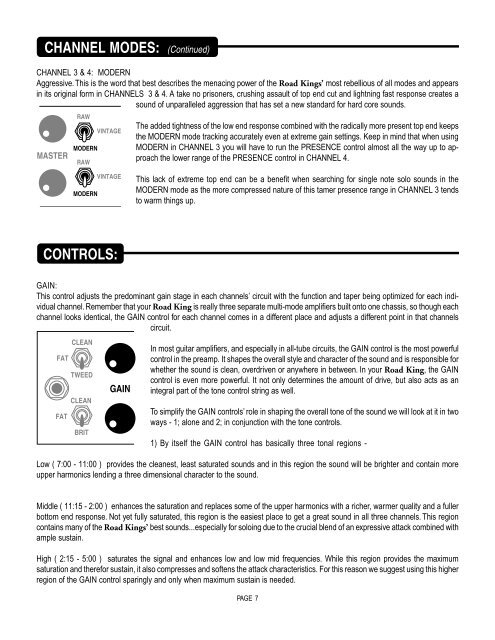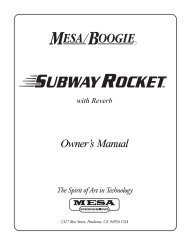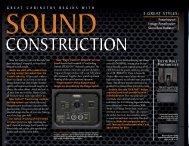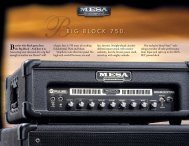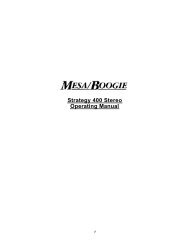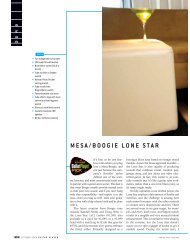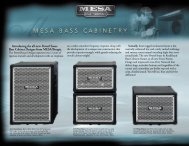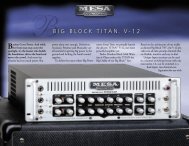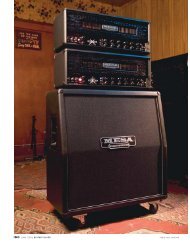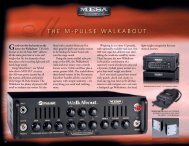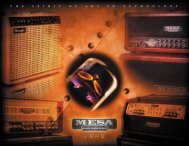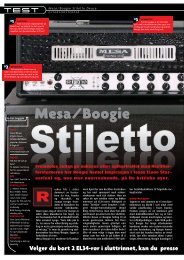Road King Manual - Mesa Boogie
Road King Manual - Mesa Boogie
Road King Manual - Mesa Boogie
- No tags were found...
You also want an ePaper? Increase the reach of your titles
YUMPU automatically turns print PDFs into web optimized ePapers that Google loves.
CHANNEL MODES: (Continued)CHANNEL 3 & 4: MODERNAggressive. This is the word that best describes the menacing power of the <strong>Road</strong> <strong>King</strong>s’ most rebellious of all modes and appearsin its original form in CHANNELS 3 & 4. A take no prisoners, crushing assault of top end cut and lightning fast response creates asound of unparalleled aggression that has set a new standard for hard core sounds.MASTERRAWMODERNRAWVINTAGEThe added tightness of the low end response combined with the radically more present top end keepsthe MODERN mode tracking accurately even at extreme gain settings. Keep in mind that when usingMODERN in CHANNEL 3 you will have to run the PRESENCE control almost all the way up to approachthe lower range of the PRESENCE control in CHANNEL 4.MODERNVINTAGEThis lack of extreme top end can be a benefit when searching for single note solo sounds in theMODERN mode as the more compressed nature of this tamer presence range in CHANNEL 3 tendsto warm things up.CONTROLS:GAIN:This control adjusts the predominant gain stage in each channels’ circuit with the function and taper being optimized for each individualchannel. Remember that your <strong>Road</strong> <strong>King</strong> is really three separate multi-mode amplifiers built onto one chassis, so though eachchannel looks identical, the GAIN control for each channel comes in a different place and adjusts a different point in that channelscircuit.CLEANFATTWEEDCLEANFATBRITGAINIn most guitar amplifiers, and especially in all-tube circuits, the GAIN control is the most powerfulcontrol in the preamp. It shapes the overall style and character of the sound and is responsible forwhether the sound is clean, overdriven or anywhere in between. In your <strong>Road</strong> <strong>King</strong>, the GAINcontrol is even more powerful. It not only determines the amount of drive, but also acts as anintegral part of the tone control string as well.To simplify the GAIN controls’ role in shaping the overall tone of the sound we will look at it in twoways - 1; alone and 2; in conjunction with the tone controls.1) By itself the GAIN control has basically three tonal regions -Low ( 7:00 - 11:00 ) provides the cleanest, least saturated sounds and in this region the sound will be brighter and contain moreupper harmonics lending a three dimensional character to the sound.Middle ( 11:15 - 2:00 ) enhances the saturation and replaces some of the upper harmonics with a richer, warmer quality and a fullerbottom end response. Not yet fully saturated, this region is the easiest place to get a great sound in all three channels. This regioncontains many of the <strong>Road</strong> <strong>King</strong>s’ best sounds...especially for soloing due to the crucial blend of an expressive attack combined withample sustain.High ( 2:15 - 5:00 ) saturates the signal and enhances low and low mid frequencies. While this region provides the maximumsaturation and therefor sustain, it also compresses and softens the attack characteristics. For this reason we suggest using this higherregion of the GAIN control sparingly and only when maximum sustain is needed.PAGE 7


